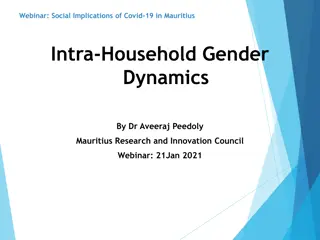Understanding the Impact of Domestic Technology on Homemakers
The research explores the incorporation of technology into household chores and its influence on homemakers. It delves into how technology, despite claims to reduce workload, often increased responsibilities for women. The study aims to assess the role of technology in modern homemaking and the extent of women's involvement in decision-making within households.
Download Presentation

Please find below an Image/Link to download the presentation.
The content on the website is provided AS IS for your information and personal use only. It may not be sold, licensed, or shared on other websites without obtaining consent from the author. Download presentation by click this link. If you encounter any issues during the download, it is possible that the publisher has removed the file from their server.
E N D
Presentation Transcript
Domestic Technology and Homemakers- An understanding of the coming in of technologies for homemakers By Devyanshi Agarwal Aditi Mukherjee Saba Khan Meghna Singh Shweta Jose
Acknowledgment We would like to thank Mrs. Amrita Shastry and all our teachers for their constant support and guidance. We would also like to thank our respondents for taking out time from their busy schedules and answering all our questions patiently.
Introduction Domestic Technology is incorporation of applied science into home. Domestic Technology claimed to decrease the workload by reducing time spent on household work. Although in reality this did not happen. By using their power as consumers, it is believed that women played extremely important role in shaping the history of electrical technology.
* Introduction of electric appliances raised the minimum standard of household cleanliness * Ironically, the overall result of labour saving electrical appliances meant more work for women. * The domestic division of labour by gender remains remarkably resistant to technological innovation. * Patriarchy was prevalent as it is the men who had the final say in decision making.
Objectives To understand whether technology is always useful for homemakers or not. To find out to what extent technology has reduced the work of homemakers. To understand whether in the present times, homemakers have an equal say in decision making or not.
Review of Literature For the review of literature, we ve referred to the following: Appliances and their impact: The ownership of domestic technology and time spent on household work by Michael Bittman, James Mahmund Rice and Judy Wajcman 1. Unpaid Work- Domestic and Voluntary Work by Stephen Edgall 2. The Ironies of Household Technology- Ruth Schwartz Cowan 3.
1. Main theme in all the books: Modern technology has alienated women. 2. It has created more chores for women. 3. Women became tied to the domestic sphere. 4. Domestic technology has mainly replaced work previously conducted by men, children and servants.
5. In reality, the chance of self expression for women has become limited. 6. They question whether domestic appliances actually save time and labour. 7. It is concluded that domestic technology rarely reduces unpaid housework.
Methodology Our universe consisted to two localities- M.S. Apartments, Kasturba Gandhi Marg and Nirman Apartments, Mayur Vihar. Our sample size was of 20 respondents. We used purposive sampling method for our research. We used the interview method and the telephonic interview method to collect data.
Limitations Unnecessary interference by gatekeeper in one case. Some respondents were not comfortable to have their responses recorded. During telephonic interview, voice of respondents was not clear. Could not conduct interviews on Sunday, as respondents were busy. In face to face interview there was a lot of unnecessary rambling by the respondents.
Data Collection and Observation For our research we used the semi structured interview method to obtain our responses. We conducted our research in two localities M.S. Apartments, Kasturba Gandhi Marg Nirman Apartments, Mayur Vihar. 1. 2. We also took the help of voice recordings in our interview. The presence of two gatekeepers in the respective colonies helped us to approach the respondents. We also took telephonic interviews of some respondents who were busy to be physically present to give the interviews.
Analysis and Interpretation
Q1. Are you active on any social media websites such as Whatsapp/Facebook? 10% 25% Both Whatsapp and Facebook Only Whatsapp No social media 65%
Q2. How much time in a day do you spend on social media? 15% 20% Less than one hour 1 hour More than one hour 65%
Q3. Do you prefer online or manual shopping? 25% Online Manual Both 50% 25%
Q4. Do you use the internet to help you with your children s projects? 25% Yes No 75%
Q5. Do you think that the percentage of women who use technology has increased with time ? Yes 100%
Q6. Who makes the final decision when you buy household items? 20% Husband Both 80%
Q7. Has the coming in of technology allowed you to indulge in any kind of hobby? 35% Yes No 65%
Q8. Have you brought any appliances that were in vogue but now are of no use to you? 35% Yes No 65%
Q9.What kind of gadgets do you use on a daily basis? Most of the women said that they used Fridges, Air conditioners, Washing Machines, Mixer Grinders, Televisions and Mobile Phones on a daily basis.
Q10. How do you think technology has changed from your mother s generation to yours? All the women agreed that there has been a drastic change in technology from their mother s generation to theirs. They mentioned how in their mother s generation everything had to be done manually, from washing clothes and cleaning to grinding spices but with the coming in of technology a lot has changed and their life has become easier.
Q11. Do you think that the coming in of technology has decreased your workload? A. All the women agreed that with the coming in of technology, their workload was reduced.
Q12. How do you spend your free time? Most of the women answered that they spent their free time watching television, walking and resting. A lot of women said that they did not get much free time since they were busy with children s work and cooking for the family.
Interpretation Technology is useful for homemakers as it has enabled them to connect with their family members and friends and helped them with housework. However, a few respondents did mention the fact that they stopped using microwaves after they found out about its harmful effects. This shows that they don t always accept technology uncritically. Sometimes, technologies which are projected to be useful are not, such as Roti makers and air fryers. All the women said that their workload was reduced with the coming in of technology. However, through probing and analysis it was found out that there has been a decrease as compared to the past, but not to a great extent.
Even though women were now more free as compared to the past, they are now expected to put that time in taking care of children and handling their school work. Most of them could not pursue their hobbies. In decision making, even when the decision was a joint one, the men took the decision in buying complex appliances. Here we see the power dynamics which operate in a patriarchal society where the realm of decision making is still primarily that of the husband.
Conclusion Hence, through our research it was found that technologies are not always useful for women. We also found that the coming in of technologies has not reduced the workload of homemakers to a great extent. Patriarchal norms of our society still persists wherein decision making is primarily the domain of the husbands.























